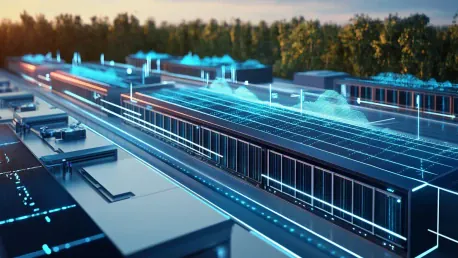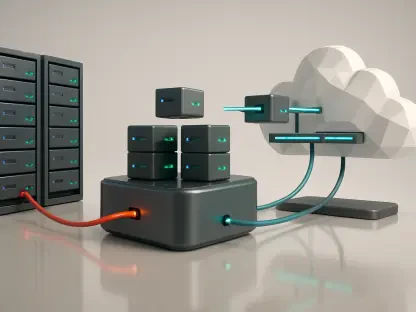The advent of artificial intelligence (AI) has fundamentally altered the landscape of digital infrastructure, with data centers standing at the epicenter of this transformation. As AI adoption accelerates exponentially, it has catalyzed an unprecedented demand for data centers, driving significant growth and prompting a reevaluation of energy consumption, sustainability, and operational efficiency. Today, data centers are integral to supporting the AI revolution by providing the necessary computing power and storage solutions. This article delves into the critical factors shaping the future of data centers, focusing on emerging trends that are set to redefine the industry and discussing how AI itself impacts their evolution and sustainability.
Data Centers and AI-Driven Growth
The continuous expansion of cloud computing and the surge in data generation have established data centers as the backbone of digital infrastructure. The current AI boom has further intensified this demand. According to CBRE, Australia’s data center market is projected to nearly double to $40 billion within the next four years as businesses increasingly invest in AI platforms. However, this rapid growth is not without its challenges, particularly in terms of energy consumption. Morgan Stanley estimates that the power demand from generative AI will grow at an annual average rate of 70% until 2027, primarily due to the proliferation of data centers, highlighting the urgent need for innovative solutions to manage energy usage effectively.
This escalating energy requirement places immense pressure on data center providers to balance the benefits of AI solutions with their energy consumption and carbon footprint, all while aligning with their sustainability goals. Providers must also consider the long-term impacts of AI investments, ensuring that the infrastructure can scale efficiently without compromising environmental and operational standards. The focus on sustainability is as crucial as fostering AI growth, thus making it imperative for the industry to innovate continuously and integrate advanced technologies that optimize performance and energy use.
Energy Management and Sustainability
Achieving a balance between AI-driven growth and sustainable energy consumption is a complex yet vital task for data center providers. Existing energy management technologies play a critical role in this equation, with widespread adoption of renewable energy sources and integrated energy management systems enhancing energy efficiency. Companies are increasingly deploying AI to manage data center operations, using machine learning algorithms to monitor and optimize energy usage in real time. This approach helps minimize wastage and enhances overall efficiency, making it possible to meet growing AI demands without exacerbating environmental impacts.
The article identifies key trends anticipated to shape the future of data centers in the age of AI. These trends, which include grid balancing and collaboration, building capacity for internet giants, the rise of AI inference, and addressing the talent shortage in the industry, highlight the importance of innovative solutions to manage energy consumption while supporting AI-driven growth. Grid balancing and collaboration with utility providers, for example, ensure that data centers can draw and conserve energy efficiently, boosting sustainability and reliability.
Grid Balancing and Collaboration
A growing effort to align forecasts and trends between data centers and utilities is underway, particularly to optimize power usage. In the future, as utilities and data centers share information, AI will be instrumental in integrating data centers into the utility power ecosystem. This will enable data centers to select appropriate power profiles and determine when to transition off-grid to use backup sources. Closer collaboration between utilities and data centers is expected to gain momentum over the next twelve months due to ongoing power shortages and the need to stabilize renewable energy sources.
The addition of battery energy storage systems (BESS) to data centers further emphasizes the importance of balancing grid management with data center service level agreements. This continuous priority is likely to lead to more formalized collaboration as the industry progresses. Data centers are not just consumers of power but can also act as a dynamic resource to the grid, providing stability and reliability, particularly in areas dependent on renewable energy sources such as wind and solar. Utilities and data centers working together can pave the way for a more resilient and efficient power ecosystem.
Building Capacity for Internet Giants
The demand for accelerated computing capacity, primarily driven by AI providers, has prompted data center operators and co-location companies to focus on building infrastructure tailored for AI-specific applications, rather than traditional enterprise or cloud applications. This surge in demand has sparked intense competition for power resources, with companies negotiating with utilities to secure energy before obtaining permits. Real estate firms, previously uninvolved in this domain, are constructing data centers to address the growing need for AI capabilities and data storage solutions.
Australia’s prominent property company, Goodman, has shifted its growth strategy to prioritize data center construction over warehouses amidst a global thirst for data storage. Such trends underscore the growing importance of data centers in supporting AI-driven growth and the need for strategic planning to meet future demands. The readiness to adapt infrastructure to AI and enhance capacity highlights the industry’s response to evolving technological needs, ensuring that there is both the space and energy to support next-generation AI applications across sectors.
The Rise of AI Inference
AI’s functionality can be divided into two types: training and inference. Training involves building models, while inference pertains to the application of these models for decision-making, content generation, and automation. The role of AI inference in data centers has advanced significantly, particularly with the increasing emphasis on edge computing to process real-time data closer to the source. This approach enhances operational efficiency and minimizes latency, critical for applications requiring immediate insights and decision-making capabilities.
Initially, industry experts predicted the creation of smaller, more efficient inference clusters near the user, facilitating edge AI. However, large companies have repurposed their extensive training clusters for inferencing, leading to the rise of ‘data center inferencing.’ This trend persists due to the availability of oversized training clusters, despite being resource-intensive. Nevertheless, a gradual shift toward leveraging edge computing for inference is expected, as edge devices offer greater efficiency, lower latency, higher data security, and application-specific customization. Data center operators will balance the use of edge computing with larger centralized infrastructures as they evolve to meet the growing demands of AI applications.
Addressing the Talent Shortage
The rapid growth of the data center industry, fueled by societal and economic dependence on digital infrastructure, has highlighted a significant talent shortage. The demand for specialized skills in project management, electrical and mechanical engineering, procurement, and contract management outpaces supply. Consequently, developing talent pools within organizations will be a continuing priority. Addressing this shortfall involves investing in training programs, creating partnerships with educational institutions, and developing career pathways that attract and retain top talent in the sector.
This talent shortage leads to the emergence of new business models within the data center ecosystem to address this skills gap. Companies are establishing training academies and internship programs to cultivate the next generation of data center professionals. This focus on talent development is crucial for sustaining the industry’s growth and ensuring the efficient operation of data centers in the AI era. By prioritizing human capital, the data center industry can maintain its trajectory of innovation and expansion, meeting the complex and evolving demands posed by AI technologies.
AI’s Long-term Impact and Future Developments
The rise of artificial intelligence (AI) has vastly transformed the landscape of digital infrastructure, with data centers at the forefront of this change. As AI adoption grows rapidly, it has led to an unparalleled spike in the demand for data centers, spurring significant growth and necessitating a reevaluation of energy consumption, sustainability, and operational efficiency. Currently, data centers are crucial in supporting the AI revolution by offering the essential computing power and storage solutions required. This article explores key factors influencing the future of data centers, highlighting emerging trends that are poised to reshape the industry. It also examines how AI itself affects their evolution and sustainability. With the increased use of AI, data centers must evolve to meet the heightened computational needs, requiring innovations in energy management and cooling solutions to maintain efficiency. Ultimately, the intersection of AI and data centers is redefining the digital infrastructure, making it more robust, sustainable, and capable of handling the complex demands of modern technology.









